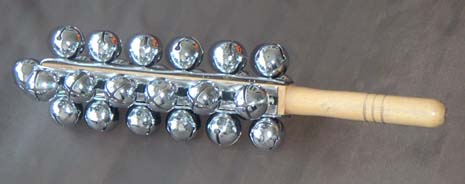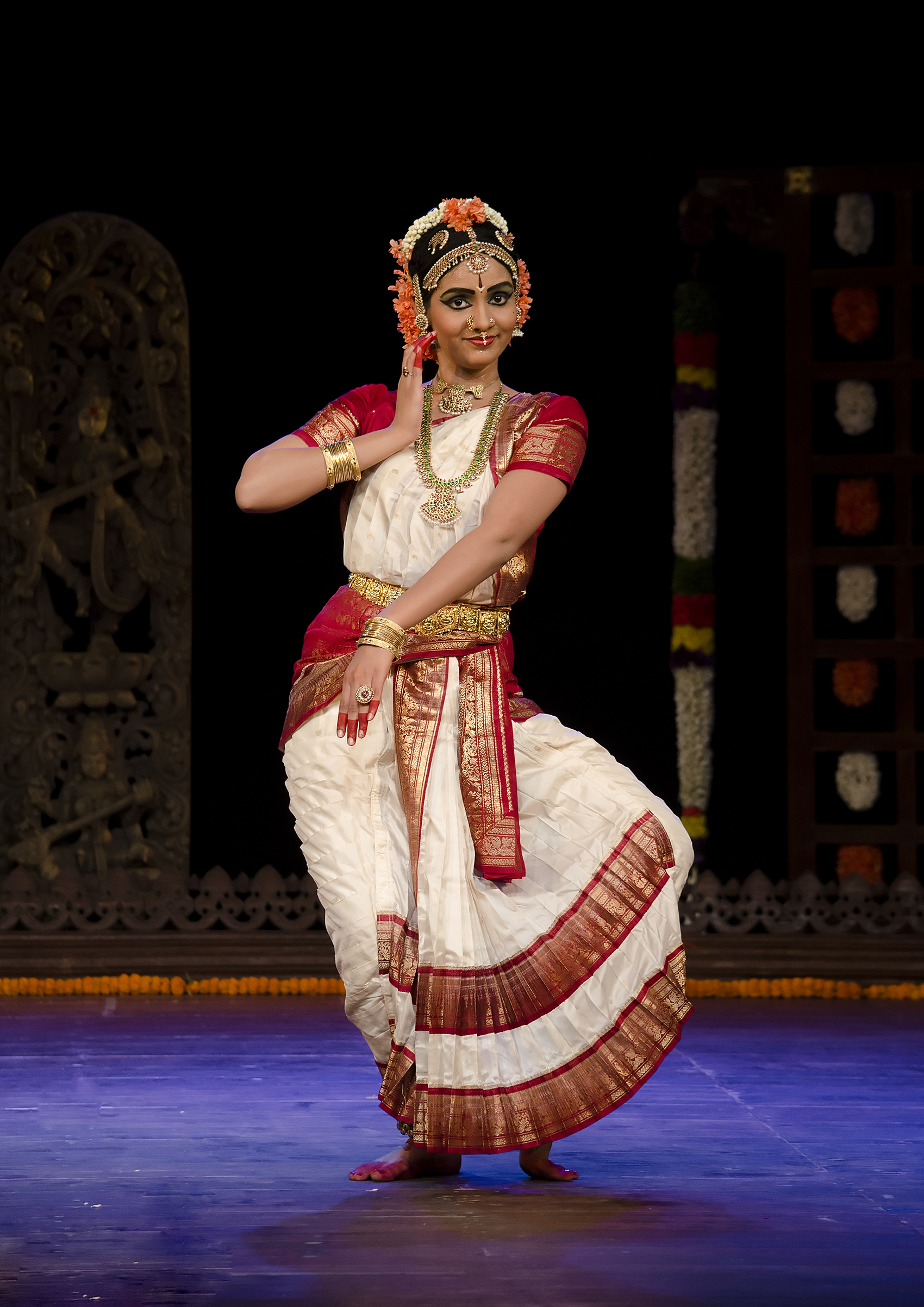|
Ghungroo
A ghungroo ( hi, घुँघरू, ur, ), also known as ghunghroo or ghunghru or ghungur or ghungura (Assamese, Bengali and Odia) or Chilanka or Salangai or Gejje (in Malayalam, Tamil and Kannada respectively), is one of many small metallic bells strung together to form ghungroos, a musical anklet tied to the feet of classical Indian dancers. The sounds produced by ghungroos vary greatly in pitch depending on their metallic composition and size. Ghungroos serve to accentuate the rhythmic aspects of the dance and allow complex footwork to be heard by the audience. They are worn immediately above the ankle, resting on the lateral malleolus and medial malleolus. A string of ghungroos can range from 50 to greater than 200 bells knotted together. Novice children dancers may start with 50 and slowly add more as they grow older and advance in their technical ability. Ghungroos are worn in traditional performances of classical Indian dance forms such as Bharatnatyam, Kathak, Kuchi ... [...More Info...] [...Related Items...] OR: [Wikipedia] [Google] [Baidu] |
Ghungroo
A ghungroo ( hi, घुँघरू, ur, ), also known as ghunghroo or ghunghru or ghungur or ghungura (Assamese, Bengali and Odia) or Chilanka or Salangai or Gejje (in Malayalam, Tamil and Kannada respectively), is one of many small metallic bells strung together to form ghungroos, a musical anklet tied to the feet of classical Indian dancers. The sounds produced by ghungroos vary greatly in pitch depending on their metallic composition and size. Ghungroos serve to accentuate the rhythmic aspects of the dance and allow complex footwork to be heard by the audience. They are worn immediately above the ankle, resting on the lateral malleolus and medial malleolus. A string of ghungroos can range from 50 to greater than 200 bells knotted together. Novice children dancers may start with 50 and slowly add more as they grow older and advance in their technical ability. Ghungroos are worn in traditional performances of classical Indian dance forms such as Bharatnatyam, Kathak, Kuchi ... [...More Info...] [...Related Items...] OR: [Wikipedia] [Google] [Baidu] |
Anklet
An anklet, also called ''ankle chain'', ''ankle bracelet'' or ''ankle string'', is an ornament worn around the ankle. Barefoot anklets and toe rings historically have been worn for at least over 8,000 years by girls and women in Indus Valley, in South Asia where it is commonly known as ''pattilu'', ''payal, golusu'' and sometimes as ''nupur''. They have also been worn by Egyptian women since predynastic times. In the United States both casual and more formal anklets became fashionable from the 1930s to the late–20th century. While in Western popular culture both younger men and women may wear casual leather anklets, they are popular among barefoot women. Formal anklets (of silver, gold, or beads) are used by some women as fashion jewellery. Anklets are an important piece of jewellery in Indian marriages, worn along with saris. Occasionally, anklets on both ankles are joined by a chain to limit the step. This practice was once prevalent in Southeast Asia, where the effect was to ... [...More Info...] [...Related Items...] OR: [Wikipedia] [Google] [Baidu] |
Kathak
Kathak ( hi, कथक; ur, کتھک) is one of the eight major forms of Indian classical dance. It is the classical dance from of Uttar Pradesh. The origin of Kathak is traditionally attributed to the traveling bards in ancient northern India known as Kathakars or storytellers. The term Kathak is derived from the Vedic Sanskrit word which means "story", and ''Kathakar'' which means "the one who tells a story", or "to do with stories". Wandering Kathakars communicated stories from the great epics and ancient mythology through dance, songs and music. Kathak dancers tell various stories through their hand movements and extensive footwork, their body movements and flexibility but most importantly through their facial expressions. Kathak evolved during the Bhakti movement, particularly by incorporating the childhood and stories of the Hindu god Krishna, as well as independently in the courts of north Indian kingdoms. During the period of Mughal rule, the emperors were patrons of ... [...More Info...] [...Related Items...] OR: [Wikipedia] [Google] [Baidu] |
Odissi
Odissi (), also referred to as Orissi in old literature, is a major ancient Indian classical dance that originated in the Hindu temple, temples of Odisha – an eastern coastal state of India.Odissi ''Encyclopædia Britannica'' (2013) Odissi, in its history, was performed predominantly by women, and expressed religious stories and spirital ideas, particularly of Vaishnavism through songs written and composed according to the ''ragas'' & ''talas'' of Odissi music by ancient poets of the state. Odissi performances have also expressed ideas of other traditions such as those related to Hindu Gods Shiva and Surya, as well as Hindu Goddesses (Shaktism)., Quote: "There are other temples too in Odisha where the ''maharis'' used to dance. Besides the temple of ... [...More Info...] [...Related Items...] OR: [Wikipedia] [Google] [Baidu] |
Jingle Bell
A jingle bell or sleigh bell is a type of bell which produces a distinctive 'jingle' sound, especially in large numbers. They find use in many areas as a percussion instrument, including the classic sleigh bell sound and morris dancing. They are typically used as a cheaper alternative to small 'classic' bells. The simplest jingle bells are produced from a single piece of sheet metal bent into a roughly spherical shape to contain a small ball bearing or short piece of metal rod. This method of production results in the classic two- or four-leaved shape. Two halves may also be crimped together, resulting in a ridge around the middle. A glass marble may also be used as the ringer on larger bells. History Bells of this type were developed centuries ago from the European crotal bell for fastening to harnesses used with horses or teams of horses. Typically they were used for horse-drawn vehicles, such as carriages and sleighs. The bell was designed to make a jingly sound whenev ... [...More Info...] [...Related Items...] OR: [Wikipedia] [Google] [Baidu] |
Bharatnatyam
Bharatanatyam () is a major form of Indian classical dance that originated in Tamil Nadu. It is one of the eight widely recognized Indian classical dance forms, and expresses South Indian religious themes and spiritual ideas, particularly of Shaivism and in general of Hinduism.Bharata-natyam ''Encyclopædia Britannica''. 2007 A description of Bharatanatyam from the 2nd century CE can be found in the ancient Tamil epic '''', while temple sculptures of the 6th to 9th century CE suggest it was a highly refined performance art by the mid-1st millennium CE. Bharatanatyam is the oldest classical dance tradit ... [...More Info...] [...Related Items...] OR: [Wikipedia] [Google] [Baidu] |
Kuchipudi
Kuchipudi () ( Telugu: ) is one of the eight major Indian classical dances. It originates from a village named Kuchipudi in the Indian state of Andhra Pradesh. Kuchipudi is a dance-drama performance, with its roots in the ancient Hindu Sanskrit text of Natya Shastra. It developed as a religious art linked to traveling bards, temples and spiritual beliefs, like all major classical dances of India. Evidence of Kuchipudi's existence in an older version are found in copper inscriptions of the 10th century, and by the 15th century in texts such as the ''Machupalli Kaifat''. Kuchipudi tradition holds that Tirtha Narayana Yati – a sanyassin of Advaita Vedanta persuasion,Krishna Chaitanya (1987), "Arts of India.", pages.74 and his disciple, an orphan named Siddhendra Yogi, founded and systematized the modern version of Kuchipudi in the 17th century. Kuchipudi largely developed as a Krishna-oriented Vaishnavism tradition, and it is known by the name of Bhagavata Mela in Thanjavu ... [...More Info...] [...Related Items...] OR: [Wikipedia] [Google] [Baidu] |
Mohiniyattam
Mohiniyattam, ( ml, മോഹിനിയാട്ടം), is an Indian classical dance form that developed and remained popular in the state of Kerala. Kathakali is another classical dance form of Kerala. Mohiniyattam dance gets its name from the word Mohini – a historical enchantress avatar of the Hindu God Vishnu, who helps the good prevail over evil by developing her feminine powers. Mohiniyattam's roots, like all classical Indian dances, are in the ''Natya Shastra'' – the ancient Hindu Sanskrit text on performance arts. However, it follows the Lasya style described in ''Natya Shastra'', that is a dance which is delicate, eros-filled and feminine. It is traditionally a solo dance performed by women after extensive training, though nowadays men can also perform the dance. The repertoire of Mohiniyattam includes music in the Carnatic style, singing and acting a play through the dance, where the recitation may be either by a separate vocalist or the dancer themselves. T ... [...More Info...] [...Related Items...] OR: [Wikipedia] [Google] [Baidu] |
Lavani
Lavani () is a genre of music popular in Maharashtra, India. Lavani is a combination of traditional song and dance, which particularly performed to the beats of ''Dholki'', a percussion instrument. Lavani is noted for its powerful rhythm. Lavani has contributed substantially to the development of Marathi folk theatre. In Maharashtra and southern Madhya Pradesh it is performed by the female performers wearing nine-yard long sarees. The songs are sung in a quick tempo. Etymology According to a tradition, the word Lavani is derived from the word '''lavanya which means 'beauty'. Origin Lavani dance originated from Maharashtra in 18th and 19th century. Lavani dancers were patronised by Maratha Lords and Kings. Lavani dance was generally performed by Dhangars or Shepherd living in the Solapur, Maharashtra. History and genres Traditionally, this genre of folk dance deals with different and varied subject matters such as society, religion and politics. The songs in 'Lavani' are m ... [...More Info...] [...Related Items...] OR: [Wikipedia] [Google] [Baidu] |
Bell (instrument)
A bell is a directly struck idiophone percussion instrument. Most bells have the shape of a hollow cup that when struck vibrates in a single strong strike tone, with its sides forming an efficient resonator. The strike may be made by an internal "clapper" or "uvula", an external hammer, or—in small bells—by a small loose sphere enclosed within the body of the bell (jingle bell). Bells are usually cast from bell metal (a type of bronze) for its resonant properties, but can also be made from other hard materials. This depends on the function. Some small bells such as ornamental bells or cowbells can be made from cast or pressed metal, glass or ceramic, but large bells such as a church, clock and tower bells are normally cast from bell metal. Bells intended to be heard over a wide area can range from a single bell hung in a turret or bell-gable, to a musical ensemble such as an English ring of bells, a carillon or a Russian zvon which are tuned to a common scale and instal ... [...More Info...] [...Related Items...] OR: [Wikipedia] [Google] [Baidu] |






.jpg)



